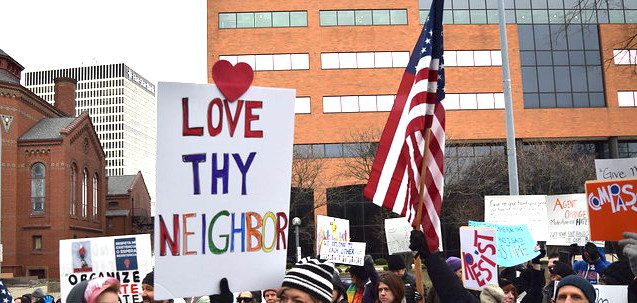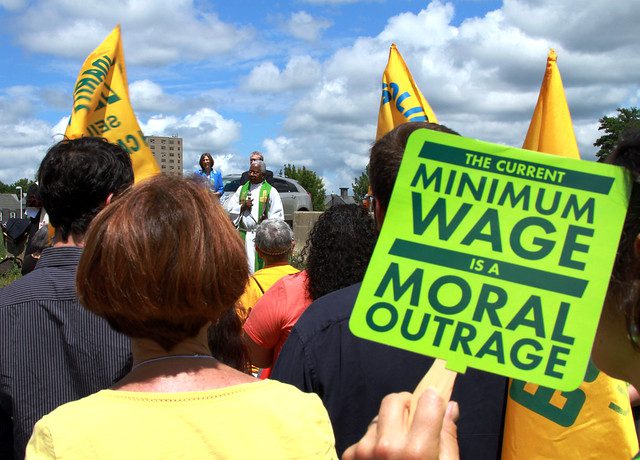| Wages Are Falling Farther Behind Housing Prices
|
A worker would have to earn $13.87 per hour – called the “Housing Wage”– to afford the national median fair market rent for a two-bedroom rental house or apartment according to Out of Reach 2001: America’s Growing Wage-Rent Disparity, published by the National Low Income Housing Coalition (NLIHC). Of the 3,779 local jurisdictions NLIHC studied, the Housing Wage increased in all but one of them, by an average of about 4.6 percent from 2000 to 2001. Five hundred local jurisdictions experienced increases of $1 per hour or more, and 99 of those saw increases of $2 or more. In San Francisco, one of the most expensive areas, the housing wage is $33.60. In 33 states and 1,237 cities and counties, the median fair market rent (determined by HUD) is more than twice the minimum wage, which has remained at $5.15 since 1997. Out of Reach 2001 is available for purchase from NLIHC at 202-662-1530 or can be downloaded for free from www.nlihc.org. |
|
|
|
| Stamford Goes “One-For-One” | The Stamford, Connecticut, city council has enacted an ordinance mandating that the city replace each unit of government-subsidized rental housing before it can be demolished or converted to a higher rent, reports the Stamford Advocate (10/02/01). The ordinance marks a dramatic shift from what has been a national trend to demolish failing public housing projects and replace them with smaller, mixed-income developments, and advocates say it may be the strongest measure of its kind. Stamford Mayor Dannel Malloy had threatened a veto because he wanted a homeownership provision added to the ordinance, but he didn’t follow through. |
|
|
|
| Homelessness Returns to ’80s Level | Homeless shelters in several major cities are reporting a return to the levels of demand of the 1980s, when recession and the mass release of patients from mental health facilities led to a surge in homelessness, the Chicago Tribune reports (8/19/01). According to New York’s Coalition for the Homeless, the city’s homeless shelters averaged 28,029 a night in July, up more than 30 percent in a year. The city’s all-time high for the number of homeless in city shelters was 28,737 in March 1987. The Chicago Coalition for the Homeless estimates that there are about 15,000 homeless people on any given night in the city but only about 5,000 shelter beds. Advocates and shelters report that the fastest-growing segment of this rising homeless population is working-poor families, such as those who have recently left welfare. |
|
|
|
| New Complex to Generate its Own Energy | Colorado Court, a new 44-unit low-income housing complex in Southern California, will generate 92 percent of its own energy. Developed by the Regional Energy Efficiency Initiative (REEI) – the cities of Santa Monica and Irvine, Southern California Edison, and the California Energy Coalition – the complex features an on-site micro turbine natural gas generator and 199 solar photovoltaic panels. Funding for the project came from REEI, the California Energy Commission, and Southern California Gas. For more information, contact Susan Munves at the City of Santa Monica, 310-458-8229. |
|
|
|
| Feds Break Contracts with Tenant Groups | Section 8 tenants whose buildings are undergoing financial restructuring through the Mark-to-Market program often need help understanding the complicated notices they receive, getting vouchers or other help to which they are entitled, and gaining a say in the negotiations affecting their homes. That’s why the federal Office of Multifamily Housing Assistance Restructuring (OMHAR) pays nonprofit organizations to assist them. Or did, anyway. It seems that OMHAR mistakenly committed money HUD didn’t have, and while an investigation proceeds, the tenant groups are not being paid for work they’ve already done, let alone for the coming year. Many may be forced to lay off staff, leaving the tenants they serve stranded. HUD has requested additional money to compensate for the mistake, but Senate appropriators are suggesting that HUD rectify the problem before any more funding is made to the groups. The problem with that approach, notes the National Housing Trust, is that it will take months, even years, to sort out this issue. In the meantime, the groups and tenants suffer. |
|
|
|
| Tenants Buy Their Building | The former owners of Chicago’s Lakeview Towers were all set to sell the property to a local real estate firm for $22.5 million, setting off fears that the apartment building would change from affordable housing to market rate condominiums after 2009 per an earlier agreement. But its ethnically diverse tenant population – including African Americans, Native Americans, Nigerian and Russian immigrants – had other ideas. They decided to exercise their right of first refusal and in October they purchased the building themselves, securing an agreement that will keep the apartment building affordable for 500 families until 2041.
According to the Chicago Sun-Times (10/18/01), the purchase represents the largest tenant takeover of a government-assisted property in state history. Nearly 80 percent of the building’s 500 units are Section 8. However, over 100 tenants raised $10,000 to add to $40,000 from the Jewish Council on Urban Affairs for escrow money. The state’s Affordable Housing Trust Fund provided a $675,000 mortgage, approved by the Illinois Housing Development Authority. Although tenants will be able to form a limited-equity cooperative next year, for now the apartments will remain rental units, owned and controlled by the resident association. Although the resident association can sell the building, the state-backed mortgage requires that the building remain affordable until 2041 under any owner. |
|
|
|
| Poor Teens Working Long Hours | Only six percent of 14- to 17-year-olds in families receiving public assistance are employed, according to the report Teens, Jobs, and Welfare: Implications for Social Policy, recently released by Child Trends. This means they are isolated from the workforce, which may hinder their transition to the world of work as adults. By contrast, about 25 percent of teens whose families recently left welfare were employed. However, most of them (seven in 10) are working long hours, which may be jeopardizing their education. Excessive work during the high school years has been associated with higher dropout rates and lower educational attainment in adulthood. For more information, contact Jenice Robinson at Child Trends, 202-3692-5580. |
|
|
|
| Tenant Organizing Isn’t Free Speech | The California Supreme Court has upheld an Appellate Court decision to forbid the Golden Gateway Tenants Association in San Francisco from distributing its newsletters and leaflets under the doors in its apartment building. The court ruled that since the property is private and not “freely, openly accessible to the public,” it does not violate free speech rights for management to forbid the association from placing anything under doors unless residents specifically request delivery in that manner. |
|
|
|
| City Provides Land for Homeless | In an unusual move for a municipality, the city of Portland, Oregon, has provided a patch of land for homeless residents living in a tent encampment. Called Dignity Village, the land contains a city-installed water hookup and portable toilets. The encampment is a fenced-in block of asphalt in a corner of the city’s leaf composting operation, between a runway at the Portland International Airport and a state prison. So far about 40 people, mainly single men, have taken the city up on the offer, according to The New York Times (9/10/01). Most residents said they preferred tents to the crowded shelters, which force people into regimented schedules and do not allow pets. The establishment of the temporary encampment comes on the heels of a vote by the city council to allow the tent city as long as it could “meet the needs of homeless people and help them move to more appropriate housing.” |
|
|
|
| HUD “Waste” Claims Largely Unfounded | As part of the never-ending battle against “waste, fraud, and abuse,” HUD has been investigating whether public housing tenants and rental subsidy recipients have been underreporting income in order to lower their rent. In fact, last year the department sent 216,309 letters to tenants it suspected of misreporting income. This investigative zeal yielded a grand total of $3 million in underpayments of rent by a mere 1,340 residents, or 0.6 percent of those suspected.
“The allegations of ‘waste, fraud, and abuse’ got a lot of airtime last year and were used by members of Congress to argue against more housing assistance for poor people,” says National Low Income Housing Coalition (NLIHC) President Sheila Crowley, “Will the baseline results get the same level of attention? I doubt it. The absence of waste, fraud, and abuse is not headline news.” |
Shelter Shorts
Community Development News
Wages Are Falling Farther Behind Housing Prices A worker would have to earn $13.87 per hour – called the “Housing Wage”– to afford the national median fair market rent for a two-bedroom rental house or apartment according to Out of Reach 2001: America’s Growing Wage-Rent Disparity, published by the National Low Income Housing Coalition […]




Comments